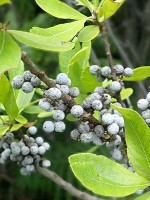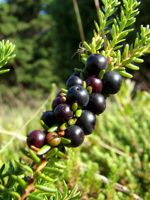Mon-Fri 9am - 5pm Mountain time
Northern Bayberry vs Black Crowberry
Myrica pensylvanica
Empetrum nigrum
NOT AVAILABLE THIS SEASON - MIGHT RETURN
CUSTOM GROW
Northern Bayberry makes an excellent hedge or feature shrub. It will retain its leaves in warmer climates but drops them in colder areas. They produce blue-grey berries that have a wax coating on them that can be used to make candles or soaps.
In colder hardiness zones the leaves turn an attractive orange to red colour in the fall, making it a striking addition to your landscape.
Northern Bayberry is native to Nova Scotia and tolerates both drought and wet conditions. It is also a nitrogen fixer that tolerates poor soil conditions.
Black Crowberry is a native evergreen shrub that forms low, spreading mats. It has unique foliage that spirals around the stem, and small dark berries, giving it visual appeal. The berries are edible, but can be acidic, so they are not generally eaten fresh. In colder climates, the berries develop a sweet-tart flavor and are often dried or used in desserts, jams, and jellies.
This hardy shrub provides food for birds and mammals, while its flowers attract pollinators such as bees. It also serves as a host plant for certain butterflies and moths. Together, these roles make it a key contributor to the health of tundra and boreal ecosystems.
In Newfoundland and Labrador, the berries are known locally as ‘blackberries’ and are enjoyed in jams, jellies, and traditional baked goods such as buns and puddings. In Scandinavia, they continue to be used in liqueurs, wines, and juices.
Northern Bayberry Quick Facts
Black Crowberry Quick Facts
Toxicity: Warning: The wax from bayberry fruit is considered toxic and may be carcinogenic.

